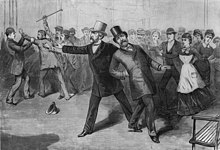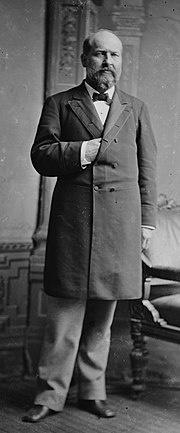
Back اغتيال جيمس إيه غارفيلد Arabic Asesinato de James A. Garfield Spanish ترور جیمز آبرام گارفیلد Persian Assassinat de James A. Garfield French רצח ג'יימס גרפילד HE Ջեյմս Գարֆիլդի սպանություն Armenian Pembunuhan James A. Garfield ID Assassinio di James Abram Garfield Italian ガーフィールド大統領暗殺事件 Japanese 제임스 A. 가필드 암살 사건 Korean
| Assassination of James A. Garfield | |
|---|---|
 | |
| Location | Baltimore and Potomac Railroad Station, Washington, D.C., U.S. |
| Coordinates | 38°53′31″N 77°01′13″W / 38.89194°N 77.02028°W |
| Date | July 2, 1881, 143 years ago 9:30 am (Local mean time) |
| Target | James Abram Garfield |
Attack type | Assassination |
| Weapons | British Bull Dog revolver |
| Victim | James Abram Garfield (died on September 19, 1881 as a result of infection) |
| Motive | Retribution for perceived failure to reward campaign support |
| Convicted | Charles Julius Guiteau |
| Verdict | Guilty |
| Convictions | First degree murder |
| Sentence | Death by hanging |

On July 2, 1881, James A. Garfield, the 20th president of the United States, was shot at the Baltimore and Potomac Railroad Station in Washington, D.C., resulting in his death in Elberon, New Jersey, two and a half months later on September 19, 1881. The shooting occurred less than four months into his term as president. He was the second American president to be assassinated, following Abraham Lincoln in 1865. Charles J. Guiteau was convicted of Garfield's murder and executed by hanging one year after the shooting.
Guiteau was an American man who had distributed copies of a speech he wrote aimed at promoting Garfield in the 1880 United States presidential election. Guiteau believed his campaigning had been vital to Garfield's eventual victory, and that Garfield owed him a diplomatic post in Europe for his assistance. After months of failed attempts to solicit such a reward from the Garfield administration, he purchased a revolver and began stalking Garfield with the goal of assassinating him.
After being struck by the bullets, Garfield was carried back to the White House, where he underwent medical treatment for over two months. His condition fluctuated, though generally worsened over time as he began to suffer from sepsis and infection. His treatment in part consisted of doctors trying in vain to find the bullet still lodged in his body; by doing so, they likely aggravated his existing wounds and introduced new sources of infection, decreasing his chances of survival. Garfield was later transported by train to a mansion in New Jersey, where he would die.
Guiteau was arrested immediately after the assassination as he attempted to flee the train station. His trial was widely publicized, and his legal team's attempts to use the insanity defense failed. He was convicted and sentenced to death on January 25, 1882, and hanged on June 20, 1882.
- ^ Cheney, Lynne Vincent (October 1975). "Mrs. Frank Leslie's Illustrated Newspaper". American Heritage Magazine. Vol. 26, no. 6. Retrieved January 24, 2007.
- ^ "The attack on the President's life". Library of Congress. Washington, D.C. Archived from the original on October 17, 2015. Retrieved January 24, 2007.